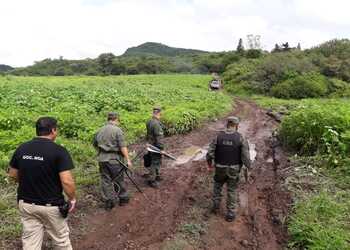A colossal seizure of more than 10,000 cannabis plants in the western provinces of Salta and Jujuy in Argentina provides evidence that marijuana growers are trying to spread the illicit crop to new parts of the country.
In early February, security forces conducted a multi-pronged operation in the provinces of Salta and Jujuy, where they seized 10,000 cannabis plants and seeds. The plants ranged from seedlings to 2,500 plants that were over two meters in height.
According to an Argentine National Gendarmerie (Gendarmería Nacional Argentina) news release, the plantation – located in a jungle area – reportedly looking like “a marijuana forest.” Two men were arrested and charged with planting and growing the marijuana but were not linked to a larger criminal group.
SEE ALSO: Salta, Argentina Profile
This was the largest ever single discovery of marijuana in Argentina and comes amid record-high seizures of drugs in the country. However, until now, the majority of drugs in the country came from Paraguay, a colossal marijuana producer.
Eduardo Villalba, the federal prosecutor in charge of this marijuana investigation told the newspaper, El Tribuno, that “this sounds the alarm that planting, sowing and cultivating has started in our country.”
InSight Crime Analysis
Although marijuana crops have been discovered in Argentina in the past, the size of this plantation and its location – far away from previous planting sites – may signal that the country is shifting toward becoming a large-scale producer.
Argentina has a well-deserved reputation as a heavy consumer of cocaine and marijuana. But until now, most of the marijuana distributed in large cities was sourced from Paraguay and smuggled through the border provinces of Misiones and Corrientes.
SEE ALSO: Argentina News and Profile
However, this may no longer be a safe way of doing business. Paraguay has led repeated operations against marijuana producers, and more scrutiny at the Triple Border Area (TBA) – where Argentina, Brazil and Paraguay meet – has seen a rise in drug seizures.
Traffickers may now be looking for alternatives. However, previous examples of experimental crops in Argentina have been much smaller and closer to the Triple Border Area.
This latest seizure was found in provinces that have a stronger association with cocaine trafficking because of its proximity to Bolivia.
Additionally, the method employed by the growers in Salta and Jujuy was very similar to that used by groups in Paraguay. They camouflaged their illicit crops amid larger tracts of land and under forest cover.
It remains to be seen whether marijuana crops will become a mainstay in Argentina. But while this seizure remains an outlier, it may lead to more such discoveries in remoter parts of the country.

